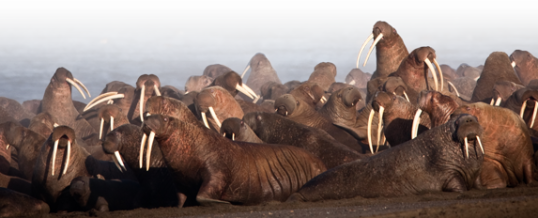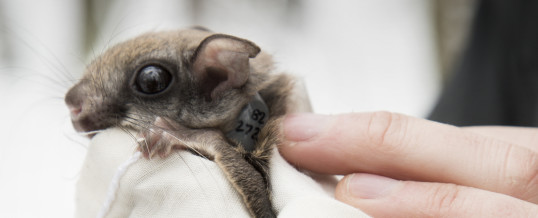Story by Clare Leschin-Hoar
There was a time when Sandra Gologergen’s freezer never ran out. Packed with traditional Inuit foods like whale, walrus, seal and fish, her freezer has been an essential lifeline, ensuring her husband, three kids and grandson make it through the long harsh winters of Savoonga, Alaska.
“Then that changed,” she says.
Warmer winters and changing ice conditions meant hunters were unable to bag the Pacific walrus the Savoonga residents traditionally relied on as a key food source. Three years ago, the situation became so dire, the governor declared the island an economic disaster to help loosen assistance funds.
“The animals are there, but the ice and weather conditions (that hunters need to harvest the animals) have changed,” says Gologergen. “I’m not the only one whose freezer has run out.”
Savoonga is a small community of around 650 residents that sits on the northern edge of St. Lawrence Island, 164 miles west of Nome, in the Bering Sea. It is among the first U.S. communities to experience the effects of climate change first hand.
Warmer winters, early springs, a shift in typical storm patterns has hampered the ability of Native Alaskan families like Gologergen’s to harvest the subsistence foods they’ve relied on for more than a millennium. The debate here isn’t over whether or not climate change is happening. For these rural communities, the looming question is whether they can continue to survive there.
It’s a similar story in tiny rural Buckland, Alaska, with a population of nearly 420. Here, worries over walrus harvests are swapped for concerns about declining caribou herds. In April, the state closed caribou hunting there to non-locals.
“Right now, a lot of people are out of caribou meat,” says Percy Ballot Sr. “Caribou used to migrate and winter in our area. Now some of the herd stays where they are, some move to the west and east. We’ve been trying to go out and look for some and haven’t seen any.”
According to Feeding America’s latest Map the Meal Gap, food insecurity rates for the state hover at 14.4 percent, just above the national rate of 14 percent. But what makes the situation in Alaska different than in many other states is its residents’ dependence on subsistence hunting, especially those who live in remote communities. In 2012, thestate estimated that rural residents harvested a whopping 295 pounds of wild foods per person — including fish, whale, seals, sea lions, moose, caribou, birds and wild plants from berries to kelp.
Food stamp benefits are tiered in Alaska, and rural residents can get as much as$1,227 a month for a family of four, but that assistance doesn’t go far at their small local grocers, where expensive transportation costs translate to sobering sticker prices. Milk can routinely cost $10 a gallon or more; a container of juice can run $13; a loaf of bread can cost $6, and a box of cereal can run $8.
It’s a dilemma Cara Durr, director of public engagement for Food Bank of Alaska, a Feeding America member, has seen first-hand.
“In places like Savoonga, suddenly you’ve got an 80 percent reduction in the amount of food you’re used to having. There aren’t a lot of jobs on these islands, and to say to people they now have to go to the grocery store — it’s just out of reach for a lot of these people. And there are hundreds of communities like this,” Durr says. “You can’t just snap your fingers and send more food. It’s incredibly expensive to ship food out there.”
The issue is more complex than just caloric intake, purchasing power and nutrition. There’s a strong cultural factor at play as well. In a report released in December, the Inuit Circumpolar Council and its Food Security Advisory Committee focused on how traditional foods will be impacted by policy making.




